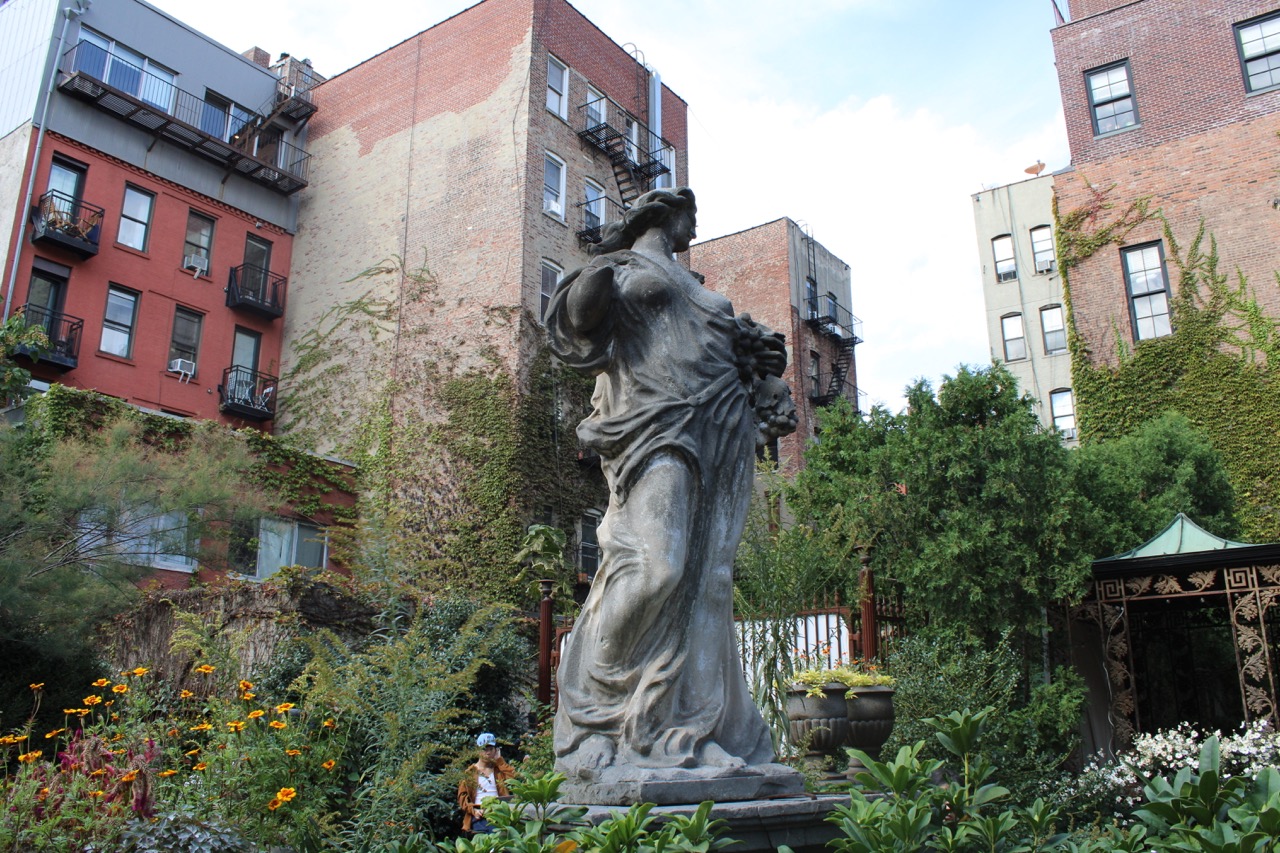
“I write this poem for all the poems from you I must leave unwritten. All the beginnings we will not stop seeking. Why, when there are such green beginnings yet to come, do they choose the gray end?”
Brian Vogel, a long-time visitor to Little Italy’s Elizabeth Street Garden, recited his ode “To a Garden Beseiged in Spring” on a chilly March afternoon. But unlike the garden’s typical poetry readings, which attract a few dozen SoHo residents on average, Vogel was reading to an audience of hundreds. The gathering of music and poetry had only been announced that morning, but there was barely room to stand in the acre of greenery.
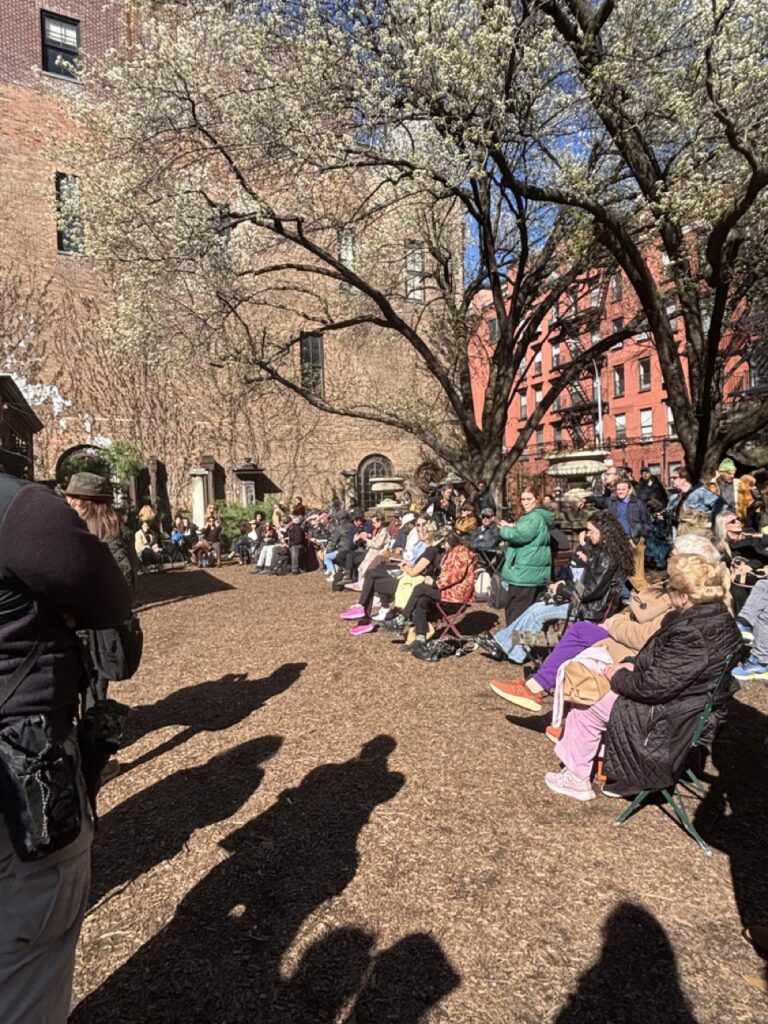
The community had gathered to protest the garden’s destruction after it had received an eviction notice—its second.
Ray Black, another poet, recounted how he had stood at the garden’s intricate pavilion and nervously recited his work for the first time, at age 61. Today, though, he had no such trepidation even as he was recorded by cable news networks and city officials.
The cameras soon panned around the crowded space, zooming in on the guest of honor: Patti Smith. Smith performed People Have the Power, sparking resilience and hope — but also sending a wave of solemnity across the crowd.
The power to dream, to rule
to wrestle the world from fools
it’s decreed the people rule,
But did the people have the power to save their garden? With the flurry of negative court decisions that had plagued ESG despite over a million letters in support, the answer seemed to be no.
Eccentric Urban Oases
Tended to — and created by — the neighborhoods surrounding them, community gardens are so ubiquitous in New York City that they sometimes become invisible. Over 600 of them, tended by volunteers, thrive in plots bordered by asphalt and concrete. Often disguised as patches of green making up corner lots between avenues, the majority of these gardens are open to the public. The gardeners who run them ask for very little in return — don’t hurt the plants, and maybe help clean up every once in a while.
“They’re these intimate community spaces that are shaped and developed by the community members who are engaged there,” said Chrissy Word, the education director at the City Parks Foundation. “That aspect of the space is hugely important, especially intergenerationally. They are a place like no other where young people and older people can come together and share ideas, stories, but particularly where they can learn from one another.”
Each garden has its own story and identity, carefully curated by the community around it, for the community around it. Some grow fruits, vegetables and herbs for nearby food pantries, others serve as aesthetic third spaces. Some are muses for artists, and others are recess fields for nearby elementary schools. A few provide volunteer opportunities as alternatives to juvenile incarceration. They are homes for everything from spontaneous potlucks to tense gang mediations.
Ray Figueroa, the president of the city’s Community Gardens Coalition and a professor at the Pratt Institute, has personally helped youth from different gangs find unity through the gardens.
“I’ve been literally in the middle of mediation where I was surrounded by gang members, waiting for the gang leader — in this case known as a shot caller — to snap his fingers and the mediation would have been over,” he said. “You can’t put a price tag on saving a life. Just can’t. And we’ve done that. And it took years to develop relationships of trust.”
Figueroa often takes his students out to nearby gardens for experiential learning. On one of these trips, he remembered seeing a plot growing plants native to Palestine.
“Talk about coming from war-torn areas and trying to salvage a sense of yourself and your humanity by planting the seeds that you brought with you,” he said. “Community gardens are really doing tremendous work in terms of helping individuals stabilize their lives.”
Because of their accessibility, nearly anyone can become a community gardener. Some gardens even let volunteers adopt a plot, giving them their own garden bed to plant and decorate as long as they meet a set minimum of hours. The majority are open for the same hours as any other park in the city, and unlike the city’s plethora of cafes, have no purchase requirement to sit and catch up with friends or study.
This flexibility is possible because over 25% of the city’s gardens — over 550 out of over 2,000 — are city-owned under the Parks Department’s GreenThumb program. It gives the gardeners resources and, crucially, the freedom to make decisions about the land.
With the city’s support, community gardens become integral pieces of every neighborhood they inhabit. That is, until the bulldozers come.
![]()
Placing Roots in Rubble
The flyers for the 44th annual GreenThumb Community Garden Harvest Festival said, “FREE EVENT. RAIN OR SHINE.”
And rain it did. Dozens of gardeners huddled together in Alphabet City, pulling their parkas tighter to hide from the chilly September drizzle. Others darted from tent to tent to collect seedlings and learn about plants native to the city’s boroughs. The few lucky enough to have remembered an umbrella stationed themselves at the cooking booth, shielding the chefs who were competing with local ingredients on smoking grills. The garden’s massive weeping willows provided some shelter, breaking the torrent into palatable, sporadic droplets, which fell into the nearby marshy pond with almost comically picturesque splashes. Surrounding the willows, on pedestals made of wood, were framed certificates of the year’s harvest competition winners — photos of gardeners beaming with their prized zinnias, cucumbers and pumpkins.
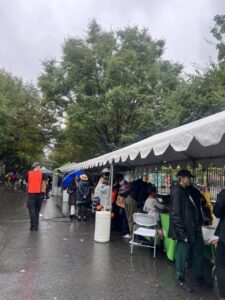
Near the entrance, a table displaying bright green t-shirts sat completely soaked through, a stream of green dye bleeding out from underneath the pile.
“Sorry, we only have extra-larges left!” said the woman handing them out.
If the weather was a test of resolve, the gardeners who had gathered that Saturday morning in El Jardín del Paraíso had passed with flying colors.
But in the early 1980s when it was first created, El Jardín del Paraíso (at Avenue C and 5th St) was hardly a paradise. In fact, with the plumes of fire that seemed to constantly pop up around Loisaida (a transliteration of the Spanish pronunciation for “Lower East Side,” originating from the rich Puerto Rican presence on Avenue C) at the time, it felt like the exact opposite: a wasteland of old car carcasses, refrigerators and household trash.
“It was one of the biggest drug shooting places in the city,” said Caroline Ratcliffe, who joined the movement in 1990 with the creation of 9BC community garden a few streets north of Paraíso. “You had junkies lining up to come back here — see the remains of that wall? They would go down into that broken basement… [workers] had to shovel out the needles and all the garbage.”
El Jardín del Paraíso’s story wasn’t unique. With the city in a financial crisis and services drastically curtailed, hundreds of tenements were turned into rubble in the 1970s. Landlords found it easier to abandon than rehabilitate, leaving neighborhoods — often with residents of color and lower income families — with dangerous eyesores.
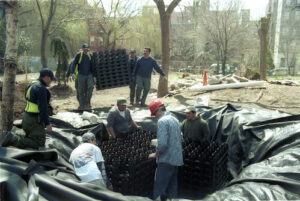
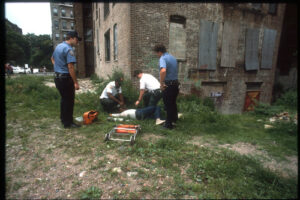
“It wasn’t homeless people like they all said it was,” said photographer David Schmidlapp, who started working on El Jardín when it was created. “People don’t like to talk about it, but it was landlords burning down their own properties and collecting the insurance.”
All around Brooklyn, the Bronx and the Lower East Side, communities wondered when the city would finally clean up their derelict lots. Spoiler alert: it wouldn’t.
Instead, a small group of determined gardeners — Liz Christy, Amos Taylor and Martin Gallent — took matters into their own hands, founding the city’s first ever community garden at the northeast corner of the Bowery and East Houston in 1973. They were the start of the “Green Guerillas,” a movement that blossomed into hundreds of empowered gardeners across the city.
“It was a form of civil disobedience,” Amos Taylor recalled in a history on the group’s website. “We were basically saying to the government, if you won’t do it, we will.”
The guerillas cleaned up garbage and planted sunflower seeds in sidewalk cracks. Fences didn’t stop them, either. Anything that could be a container — balloons, ornaments, even condoms — were filled with soil and seedlings and tossed over the barriers of the razed-down lots. They put in thousands of dollars of their own money (an unfathomable amount in the`70s) to test soil, identify problem sites and design areas for neighborhood children to play in. The New York Times reported that the group worked with “as much energy and imagination as if they were dealing with the gardens of Versailles.”
“The attitude at the time was, ‘there’s all this empty land, so why not dance on it?’” Schmidlapp said. “Why not grow on it?”
In 1985, when Christy died of cancer, the Bowery garden was renamed the Liz Christy Community in her honor. It stands in the same spot today. But many gardens have not had that kind of continuity.
The same year that Christy died, Adam Purple, a man whose last name came not from lineage but from his favorite color, which he always wore, had been cultivating his own Garden of Eden in the Lower East Side for a decade. A staunch environmentalist, he traveled only by bicycle and lived a zero-waste lifestyle long before it became an Instagram trend. His 15,000-square-foot garden, which stood on the rubble of the very tenement he used to live in, was a circular maze with symmetrical yin-yang bushes in the center. He had wanted to expand it with greenhouses and sculptures. But when a judge ruled against him, Purple had to watch the paradise he had cultivated destroyed from his own window.
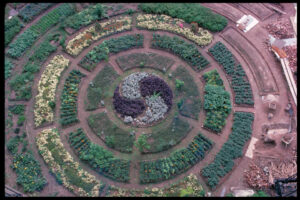
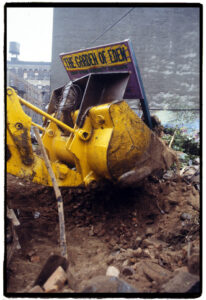
“When that garden was taken away, he said, ‘It would have been better if they killed me instead of killing the garden,” recalled Magali Regis, the vice president of the Community Garden Coalition and the stewardess of many city gardens, including the famous 6BC garden in Alphabet City. “There was a lot of activism to save the Garden of Eden. There were Purple’s footsteps from a lot of places in the Lower East Side bringing you to the garden, so if you followed the footsteps, you would see that now it’s a nondescript housing development.”
The attack on gardens ramped up in 1994, when then-mayor Rudy Giuliani surveyed city-owned plots for housing development, to be sold to the highest bidder. Three thousand were selected as viable sites; hundreds of these were community gardens under GreenThumb licenses. By 1997, a Times headline asked the question that the movement would grapple with over the next five decades: “Is This City Big Enough For Gardens And Houses?”
“Do we sacrifice gardens to build housing?” Fran Reiter, the deputy mayor for economic development and planning at the time, said to the Times. “You’re damn right we do.”
Slowly, then faster, gardens in every borough were bulldozed. Some gardeners woke up to find their trees and plants entirely destroyed, while others were able to secure alternative sites. The Bronx lost spots like the Crimmins Group Association Garden and the Hostos Herbal Medicine and Cultural Garden. Harlem lost its Garden of Love, which resided in Public School 76 and was aptly named by the students who cultivated it.
By May of 1999, over 100 gardens were slated for development, and a proposed sale of over 600 additional gardens was in the works. Protests were small, and when they escalated, police got involved. The 22-year-old Esperanza Garden in the East Village — ironically translating to hope — saw community members standing guard outside of it 24/7 to prevent demolition. When the bulldozers came, people chained themselves to fences and started chanting, leading to dozens of arrests. The garden was gone in 15 minutes.
The destruction was met with resistance efforts just as quirky as the gardeners who championed them. Matthew Power, a 24-year-old journalist, dressed as a sunflower and climbed a tree in City Hall Park in 1999, demanding to speak to the mayor about the auction. Giuliani didn’t say a word. Power was arrested, and the protest proved futile.
![]()
A Microcosm of the Movement
Elizabeth Street Garden’s battle with the city, now at a boiling point, has been simmering for over a decade. The garden was put into a development plan in 2012; in 2017, the city selected the proposal for a 123-unit affordable rental complex for low-income seniors called Haven Green. As the project made its way through land review, the garden began litigation and a massive letter-writing campaign — supported by the likes of Robert De Niro and Martin Scorcese — to save it. Nearby elementary school children contributed handwritten notes about their love for the space (“One reason why we should keep the garden is because with all the trees, we can play hide & seek and eat lunch,” one note reads.)
“It would be devastating if the garden got demolished,” said Joseph Reiver, the son of the garden’s founder. Reiver tends to the foliage most days, with his curly hair up in a bun and donning his typical uniform of a denim jacket, green bandanna and gardening boots. “It would be devastating for me, for everyone in the community, and the city in the long run would have lost something that it will never get back.”
Joseph’s dad, Allan Reiver, was the owner of the next-door Elizabeth Street Gallery, and had rented the lot from the city in 1990 on a month-to-month lease. He was initially looking for a space to store sculptures from his art collection. He cleared the lot, planted trees, installed a gravel path and erected a lean-to near the back. The two marble lions that stand guard at the garden entrance became its hallmark, the main symbol of the garden’s resistance.
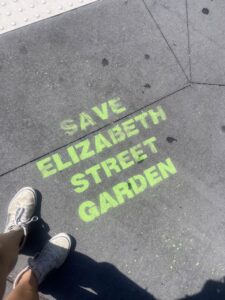
“Most people thought he owned it,” Joseph said. “Including myself.”
In 2012, District 1 City Council Member Margaret Chin, who had run on an affordable housing platform, proposed a separate land project for a different community board. What no one realized, however, was that ESG had been penciled in as a last-minute addition. The Department of Education was no longer its owner; the New York City Housing Authority now decided the garden’s fate.
According to Joseph, no one — not even his father — knew about the decision until over a year later.
After Allan found out about the change, he immediately opened the garden up to the community and neighbors came together to form the Friends of Elizabeth Street Garden non-profit, running public programming. Regis remembered the residents first coming to their meetings, asking how to bring a community garden to life.
“It was private, but when the community got together to turn it into a community garden, it truly became one,” she said. “So what’s the argument that it wasn’t before? Well, it is now. It’s basically the poster child of community gardens with all the events they organize, all year long.”
Despite the outcry, the city sent out calls for development proposals in 2016, selecting Haven Green a year later. Allan Reiver passed away in 2021, two years into ongoing litigation between the garden’s nonprofit and the city.
“This is my soul,” he had told the website 6sqft.com in 2019. “This was supposed to be my legacy to the city.”
But Haven Green, supported by the likes of Habitat for Humanity and Pennrose — a known nonprofit affordable housing developer — had its own arguments for development. Reiver had proposed alternative sites, but the developers said that they were simply additional options for building. Affordable housing needed to exist in SoHo — as much of it as possible.
“The voices of those that see themselves as losing something are always going to be louder and more passionate and with the backdrop of what exists versus renderings of what could be,” said Matthew Dunbar, a Habitat for Humanity representative that was part of the development team for Haven Green. “It’s dependent on the people who are currently there, enjoying the space, to partner in designing, stewarding, volunteering, and engaging with the future space.”
While ESG’s erasure would be accompanied with a slightly different green space integrated into the affordable housing development, this change was unacceptable for the community who had grown to love the garden, its stone lions, and its sunlight.
“If the garden could be physically moved with all its trees, all these artifacts, you all the bushes, the gazebos, the sculptures, et cetera, if that could be taken and then auctioned off to the highest bidder, a lot of cities would want this garden,” Regis said. “It’s like a little gem, right? And yet we see no value in it. The city here sees no value in it.”
![]()
Sowing Resistance
Karen Washington was one of the founders of the city’s community gardens movement, having played a pivotal role in keeping them alive. By the time she moved out of New York City, she had already fought against Giuliani and DeBlasio’s efforts.
“If you just look at the political landscape itself, it’s all about power,” she said. “It’s not about community needs. They’re not listening, they’re positioning themselves to hold on to power and they dictate that power from a top-down mentality because if you give into the community, it’s seen as being weak. And again, there’s the perception of Black and Brown people of color: ‘they don’t know what they’re doing, they need help, they need to be guided.’ ”
Washington had been a community gardener since the ’80s. A single mom, she was ecstatic when she was able to move into a brand-new affordable housing unit in the Bronx. When she looked across the street, however, her view was an empty lot strewn with garbage and tires. It was more than an eyesore; it became a reason to mock the neighborhood and its residents, a reason to avoid her street. One day, when she saw a man with a shovel digging up the rubble for a community garden, she joined in. By the time Giuliani planned to sell the gardens — including her own — she was more than committed to the cause.
“For ten years we were riding high, we were changing the complexion of the Bronx. Our neighborhood now felt safe,” she said. “We had trees, we had flowers, we could grow food. It just changed the neighborhood from being desolate into something that was vibrant and happy and just full of love and joy. And then you had this mayor who decided without notice, without even talking to the community, that he’s going to auction off — in the middle of the night — auction off gardens.
“And how did I feel? How did we feel? Betrayed,” she said. “Because this was sweat equity. The city paid us nothing to take care of these empty lots and these spaces. So in fact, we were saving them money and to be betrayed by the mayor who thought nothing about the community, it was heartless. And so you have that initial shock. You don’t know what to do, what’s going on. And then all of a sudden it clicks in. Yes, something has to be done because it’s not just happening to our garden. It’s happening to all the gardens in New York City.”
Washington created the now-thriving Community Garden Coalition, bringing together a cohort of community gardeners and legislators to advocate for the lots. Nonprofits noticed.
The biggest push of support came from thriving actress and singer Bette Midler, who had moved back to New York in 1994. After realizing just how neglected the city she loved had gotten, she grabbed a shovel and headed to Fort Tryon Park in Washington Heights, set on cleaning it up. Eventually, Midler used her celebrity status to create and fund the New York Restoration Project, with the goal of revitalizing the city’s greenery. The NYRP has planted over a million trees in the city, replenished 80 acres of parkland and — perhaps most notably — purchased 52 of the gardens Giuliani was auctioning the day before their sale.
The other half were purchased by the Trust for Public Land, an already established green space nonprofit at the time.
“Green spaces are what make dense living livable, otherwise we would all be insane,” said Tamar Renaud, the New York State Director of the Trust for Public Land. “In order to live densely in cities, which is the ecological way to live — we produce a lot less energy when we live together than when we live very sparsely populated — [we have] to have green spaces around us, places to walk, places to meet people, places to gather.”
Although the plots were ultimately saved, either through private nonprofits or by gaining permanent recognition as city parks, Giuliani’s administration sent a clear message to the gardeners still under GreenThumb licenses: the land that they had cultivated for decades wasn’t truly theirs, and the city could take it back whenever they wanted. Warnings were optional.
A saving grace came in the form of New York State Attorney General Eliot Spitzer, who sued the city, arguing that gardens should be considered as part of required environmental review before construction over them began. Michael Bloomberg’s administration, sympathetic to the gardeners’ struggles, settled Spitzer’s lawsuit by moving hundreds of gardens under various city departments’ jurisdictions. When Mayor Bill DeBlasio tried to develop over 40 city-owned GreenThumb gardens again in 2015, more rallies followed. Official city maps had mistakenly marked the sites as vacant lots, but the City Hall protests proved they were anything but. The gardeners achieved bittersweet success; while a handful were bulldozed, the majority remained preserved under the Parks Department.
“These gardens are always in danger,” Chrissy Word said. “Always.”
![]()
Fighting a Drought
At first glance, the late October protest outside City Hall looked like a fever dream. People dressed in sturdy denim jackets stood shoulder-to-shoulder with people in colorful butterfly costumes straight out of Alice in Wonderland. Some protestors were well into their seventies, needing help climbing the concrete City Hall steps; others were in their early twenties, sporting campy capes embroidered with massive tomatoes, vines and cucumbers. Despite their differences, there were two things they all had in common: a green beanie and a demand.
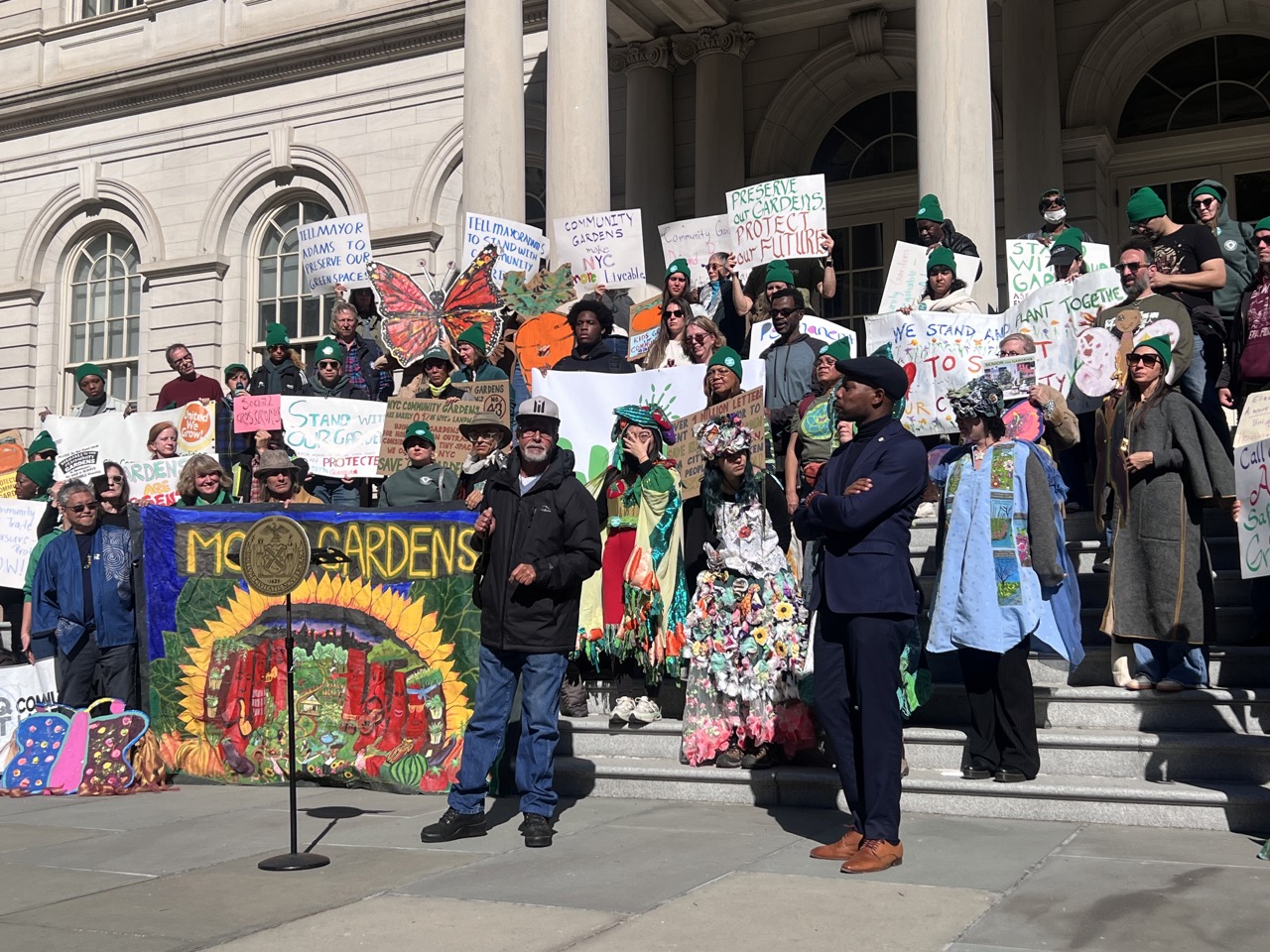
“NO MORE 43! WE NEED STRONG AND GREEN!” they chanted. Then, more straightforwardly: “SAVE OUR GARDENS!”
Despite the side eyes from councilmembers dodging them and the chilly fall wind, the gardeners remained steadfast. They didn’t know for sure if Mayor Eric Adams had actually gone into work that day; but if he had, a flash of green would have been unavoidable from his top floor view.
While most of the signs at the October rally had short phrases and slight digs at the Mayor, one stood out with a simple, yet blunt, message. Printed on a single sheet of paper, it read, “Pitting gardens against housing for the sake of a development deal is a sleazy move.”
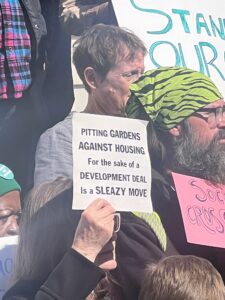
Housing vs. gardens has been a long standing debate, but advocates argue it is a false dichotomy.
By this point, the “pitting” they were discussing had become all too familiar — community gardens had always been the first to go under sweeping affordable housing deals. And the need for these deals has only been increasing since then, with the city facing the worst housing crisis since 1968.
“We see older adults that are living in deplorable conditions: lack of heat, lack of hot water, uneven floors,” said Jennifer Vallone, the Associate Executive Director for Adults, Arts, and Advocacy at University Settlement, the country’s first settlement home. “Sometimes they’re living in 4th floor walk-ups. When you’re 80 years old, you can’t live in a 4th floor walk-up any longer. We also see that people are paying sometimes 60 to 80% of their income. That is untenable.”
One of the families Vallone worked with needed repairs in their apartment. They had a hole in their ceiling, corresponding to a hole in the floor of the apartment above, where a senior lived. The senior’s cat would hop through the hole between the apartments, sometimes nestling in the family’s apartment without anyone noticing. “That’s egregious, right?” said Vallone. Yet this tenant was still better off than the over 300,000 seniors who were currently waiting for affordable apartments around the city.
It was clear that anyone running for city office needed to make housing a priority, even more steadfastly than Giuliani and DeBlasio. In August 2024, two months before the October rally, Mayor Eric Adams announced Executive Order 43. The order called for the creation of a task force to review every plot of land under the city’s ownership to consider for development. As long as building on it could happen “without disruption to critical operations,” the land was viable for housing.
Until now, the gardens’ establishment under the Department of Parks and Recreation had been their saving grace. But the mayor’s executive order applied to every single department, including Parks. There was no language addressing community gardens specifically, so gardeners didn’t know whether or not to expect bulldozers. Most land databases hadn’t yet updated their status from “vacant lots.” The GreenThumb leases stipulated that they could be terminated at any moment. Their future depended on a simple question: did community gardens count as “critical operations?”
![]()
Blooming from the Bottom-Up
Community gardens provide a unique, bottom-up approach for communities to design space to fit their needs, whether that be by growing necessary crops in food deserts or providing activities for children. This a level of intimate collaboration that can’t happen at the city level, advocates say.
Melanie Reyes is the housing director for Nos Quedamos, a Bronx-based advocacy and development group that focuses on small affordable housing units around the Melrose neighborhood. But outside of these developments, Nos Quedamos also created the South Bronx Land and Community Resource Trust, giving Melrose residents authority over their land. They also support and provide resources for the neighborhood’s community gardens, including by publishing a 2014 study on how the gardens were helping improve morale and unity.
Many community garden advocates have called the choice between housing and community gardens a false dichotomy. For Reyes, community gardens and housing are not only both achievable, but rather two sides of the same coin: self determination for neighborhoods.
“At first, it kind of looks as if everyone has to struggle for land — everybody has to struggle and fight for the space that they can take up,” she said. “But my experience with Nos Quedamos and the work that we’ve done so far, I would say that we actually combine them both.
“One of the biggest examples, we have a building called Jardin de Selene. It’s one of the buildings under our ownership in which we can help provide affordable housing, and there’s also a rooftop that has a community garden. This is just an example of how intentional planning and community-driven design can really help to foster both of these critical needs that the city has,” she said.
Reyes also recommended repurposing empty corporate offices and college dorms that have fallen out of use for affordable housing before considering green space. Her perspective of intentional design isn’t uncommon; for most grassroots advocates, the coexistence of housing and community gardens is common sense. This coexistence will look different, however, for every single neighborhood based on its topography and community, so a one-size-fits-all solution by corporate developers will inevitably result in sacrifices.
“The Department of Housing Preservation & Development, for example, can increase their trust in community land trusts, and what it means for a community to quite literally own public goods,” she said. “There is something called PLPG — Public Land for Public Good — and it goes into the process of city-owned land finally being put in the community’s hands and what this can mean in order to kind of stop this competition that seems to exist between the two. Both of them are extremely necessary.”
Community Land Trusts — like the ones that purchased the auctioned gardens at the eleventh hour back in the ’90s — serve as mediators between the community and city by purchasing plots of land and then turning over their management to neighborhood residents. Concentrated trusts focused on subsections of the city can hold meetings and town halls before changing the land, a luxury that isn’t available to fast-paced city developers.
When development happens on city land, recommendations from the community board and borough president are taken into account. However, these resolutions can ultimately be overruled by the city planning commission and city council. Often, community boards will ask for provisions specific to their neighborhoods before approving land review, whether this be improving green space, reducing construction noise or other issues. But actually fulfilling these requests is, ultimately, optional.
The other option for community gardens to have their voice heard is through the State Environmental Quality Review Act, which requires all local and state level agencies to consider the environmental impact of their decisions prior to approving them. Developments like the one at Elizabeth Street Garden must pass an environmental review before they can be greenlit. The Green Guerrillas and Community Gardens Coalition led an initiative to consider these gardens as “Critical Environmental Areas,” making them essential to this review process.
The proposal passed both the State Senate and Assembly, reaching the governor’s desk in November 2023. The bill would have codified community gardens at the state level, giving them protection for perpetuity — so when Governor Hochul vetoed the bill, lumping it in a package with 31 others, it was a big blow to the movement.
“There was really strong support for it on the part of many, many, city lawmakers and state lawmakers,” Sarah McCollum Williams, the Executive Director of the Green Guerrillas, said. “I really don’t know why she would have vetoed this when it had such strong support. It doesn’t make sense to me.”
On the ground level, support for both gardens and housing remains strong. But as proposals move higher through executive levels, politicians take stances on the matter, and a pro-housing initiative snowballs into an anti-garden aftereffect.
![]()
Putting the Community in Community Garden
The most common use of community gardens is as third spaces. The concept of a “third space” was coined by sociologist Ray Oldenburg, who identified an increased need for socialization happening in places outside of the “first space” (the home) and the second space (work). Especially in a city as fast-paced as New York, community gardens provide an accessible location for people to connect with each other, engage in hobbies and take a break from work — all for free.
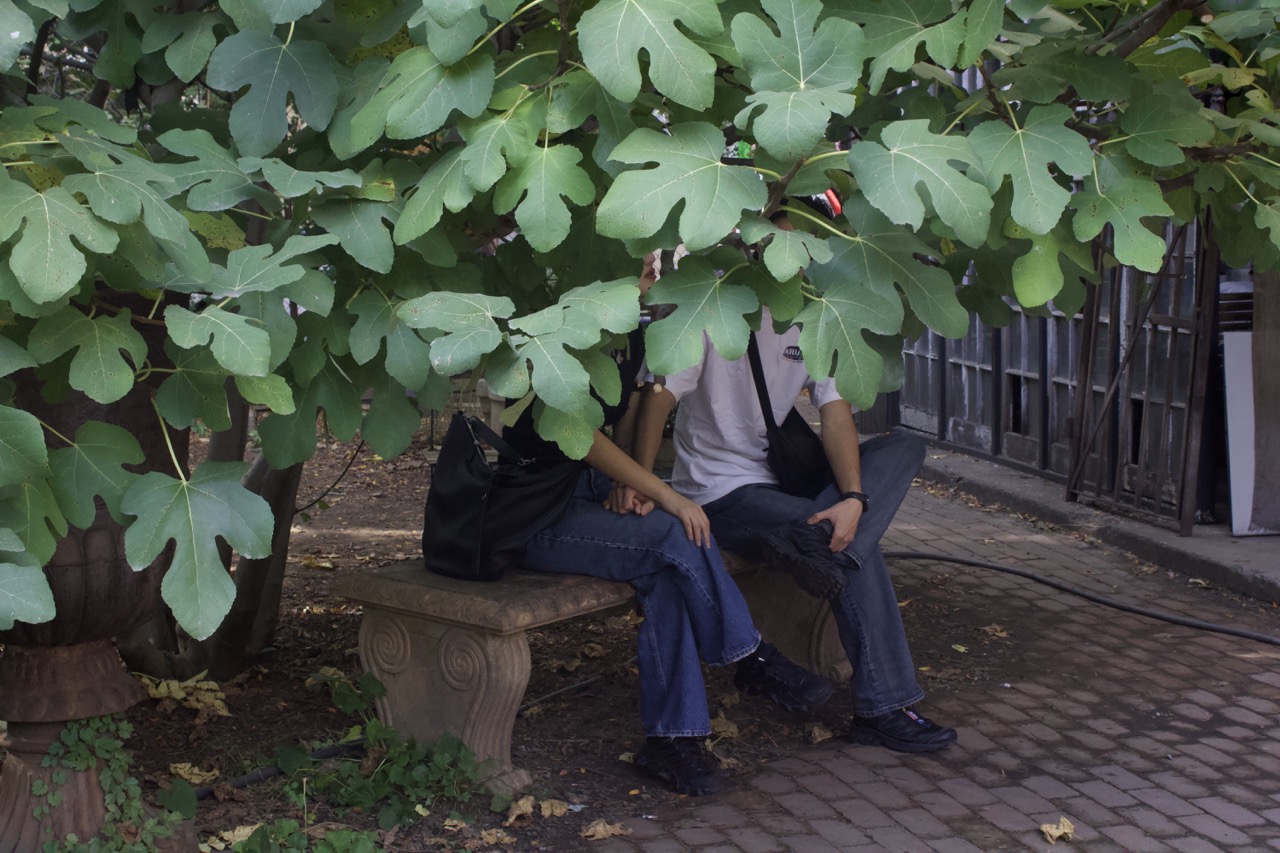
Multiple decades after creating el Jardín del Paraíso, David Schmidlapp still lives in an apartment directly next door to it. Every weekend, he holds volunteer hours where neighbors can clean up the garden. After showing me his photographs of the garden in the ‘80s, he unlocked the fence and asked me if I wanted to help out. I had brought a friend with that exact intention in mind, and David didn’t hesitate to assign us various tasks. It was mid-March; the last frost was coming up, and preparations for the growing season were in full swing. While David and another volunteer tackled the garden’s large swampy man-made pond — he didn’t want me to dirty my shoes — my friend and I fertilized and raked the massive central field.
David had planted grass the week before for the kids who spent recess in the garden, because he had learned that their own school lacks a comparable recreational space. Benches and garden beds made up the periphery.
As my friend and I worked, we developed a system; she spread the fertilizer in an area, I raked it in, and then we moved to the next small plot in a spiral that started at the edge of the garden and ended in the center. It took some figuring out, but soon our system became intuitive, and we spent almost an hour chatting, laughing and working. The large area had seemed daunting at first, but by the end, we didn’t even realize that we had covered the entire plot. Afterwards, David asked us to move the garden’s benches to the areas that got the most sunlight — a three person job. He used to be able to do it himself, he said, but now he needed more muscle. I helmed the front of the bench, walking backwards through the garden, while David and my friend took the back and directed me. It was our first time meeting him, but within a few minutes, we were already trusting him to make sure we didn’t fall.
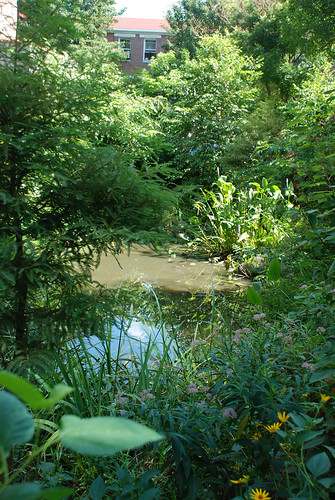
Afterwards, we cleared up leaves near the pond. A woman walked past, yelling “Y’all are doing good work!” to which David responded, “I know! When are you going to help?” She laughed, paused her walk, and came inside. She asked me if it was my first time working, and I said yes.
“Did you know all of this used to be burnt down?” she asked. “David and everyone cleaned it all up.” They joked together as we worked, clearly connected by the garden. It was a history they were proud of, decades-old memories shared by the neighborhood. David sent us home with some sage and oregano from his garden bed — something he’d always do for visitors. “Put it in some chicken or pasta,” he said. Next week would be arugula. Perfect for spring salads.
My arm was sore for several days after volunteering there. My friend said the dirt under her fingernails took a while to pick out. We hadn’t been able to check our phones in hours. But when I asked her if she wanted to go again, there was no hesitation: “Yes, of course.”
“It’s a whole lot of networking, it’s like a cute little family,” said Ursula Chance, another veteran of the city’s community garden movement. Chance is now the Director of the New York Botanical Garden’s Bronx Green-Up program. “You’re not really receiving anything from it. It’s not transactional. It’s generosity and it’s true integrity; it’s physically demanding and not a lot of people are up for it. And it’s surprising to see how many people are able to, especially elderly people who’ve been working in these gardens for God knows how long, and they continue to relentlessly.”
![]()
Growing New Roles
Over time, Chance explained, community gardens have expanded their purpose from social hubs and aesthetic enclaves to solving systemic issues, from food insecurity to stormwater drainage.
During the pandemic, Chance worked with Figueroa to form the Bronx Community Farms Hub Network, which has 18 or more gardens who work together to distribute food. They have programs that give people certificates in various skills, from pruning to ecological gardening, and they host local harvest markets. The network donates between 15,000 to 25,000 seedlings a year.
Figueroa recalled how the food insecurity aspect also played into the gardens’ rehabilitation efforts, especially with incarcerated youth.
“The first question I ask a youth that’s been incarcerated, it’s, ‘hey, did you eat today? Are you okay?’” he said. “We take that approach before talking about, ‘hey, we’re gonna compost, we’re gonna transplant seeds from the greenhouse, we’re gonna water, we’re gonna weed, we’re gonna harvest,’ before we do any of that, we make an investment of time and energy in the well-being of that person.”
The gardens also serve as a reclamation of ignored land that is inextricably linked to race and socioeconomic status. The majority of community gardens are in neighborhoods in the Bronx and Brooklyn, which consist primarily of low-income people of color. For these communities, development has been linked to displacement; they find themselves pushed out as gentrification ramps up, unable to make decisions about their own neighborhoods.
“Community gardens are very much a response to policies of marginalization where [people] have reclaimed their sense of community via reclaiming areas where [they] were devastated by policies such as redlining and plant shrinkage,” Figueroa said. “So it’s a power dynamic.”
Sunset Garden in Ridgewood, Queens, has only been around for two years, but it was created the way most community gardens are: residents noticed a plot of land sitting unused and worked to renovate it with the city. It soon started following the same steps as its predecessors, hosting events to plant poppies to free Palestine and supporting the community’s trans population amidst attacks from the Trump administration.
This support also included the installation of a ceramic altar reminiscent of stained glass, depicting transgender community leader Cecilia Gentil. When community member Cristina Wilkinson — who had already called the garden members “crazies” for their other political activism — complained about the altar to a friend who was also a city councilmember, the garden received an order to take it down. The order cited a GreenThumb rule restricting memorials, even though the altar was much smaller than the memorials the rule concerned. The subtext was obvious: remembrance of a trans woman made the wrong people uncomfortable, and the garden was to blame.
“Cecilia Gentili was a pillar of our community,” Sarah McColumn Williams said. “After all of the struggle trans and immigrant communities have been through — and the publicly documented inaction from the Adams administration in showing support for our communities — it is appalling that the Administration would use resources to erase a very small celebration of a trans immigrant woman that did so much for so many New Yorkers.”
Their unique role as outlets for marginalized communities have made gardens constant homes to grassroots movements and progressive advocacy, even when tensions with the city threaten to take them away.
![]()
A Price Tag on Planting
It’s hard to define exactly where these gardens fit into the “critical operations” of the city. Benjamin Ratner, who wrote his master’s thesis for the Pratt Institute on community gardens and land value, discovered a fundamental disconnect between the way the city valued land and the way community gardens operated. When calculating the value of a piece of land, New York City determines what the “highest and best use” of that plot would be; subjective terms that, when boiled down, refer to solely the most profitable use — what the highest bidder would pay.
Community gardens, whose civic benefits don’t have monetary equivalents, don’t fall into this equation.
“The ‘highest and best use’ paradigm thus values land as a product rather than a place,” Ratner argued. “Indeed, it is a placeless and peopleless definition of value, one that refuses to see land as an integral piece of a community’s social fabric.”
But the profit definition of value is far from the only one. In Naples, Italy, a redefinition of land use in 2012 led to the incorporation of “civic added value,” where the contributions of land to a community are taken into account. Through this framework, citizens can identify a public property and submit a request for it to be designated as a “common good” for
“urban civic and collective use.” In order to qualify, a space must simply provide unpaid and unrestricted access, be governed by its users, and allow for a rotation of social and cultural activities — criteria that every community garden, by definition, automatically meets.
“The places we hold dear — the handmade, the spontaneous, and the rebellious; the neighborhood spots where we are known; the places where we build community — these can only survive if we become a city of roots,” Ratner wrote.
Elizabeth Street Garden is no exception to this concept of civic value. The garden hosts weekly free Tai Chi Sundays with local instructors and poetry readings open to the public. Live musicians play as often as feasible, providing ambient noise as friends chat, kids grow up and people meet their significant others. It’s hard to decide whether these operations are considered “critical.” But, at the very least, they’re irreplaceable.
![]()
This spring, supporters of ESG filed a desperate, last-minute request for an injunction against the city under the Visual Artists Rights Act, urging the government to classify the garden as an important work of art. The injunction was denied in late March, and the chances for the garden’s appeal continue to grow slimmer. Reiver doesn’t know when fencing will go up, but the city could close the space to the public any day.
A glimmer of hope came from newly-appointed First Deputy Mayor Randy Mastro, who was formerly Giuliani’s Chief of Staff. Part of Mastro’s role is to review the ESG development, and he has reportedly been voicing his support for the garden to Mayor Adams. Despite the court decision, the garden still stands a month later, possibly because of Mastro. But so far, even with its famous supporters, the Adams administration remains publicly set on continuing with developing the space for housing.
The back-and-forth between ESG and the city raises concerns for New York’s hundreds of other lesser-known gardens: how will resistance work when a garden doesn’t have the backing of powerhouses like Mastro, De Niro and Scorcese?
Every day, ESG’s Instagram posts a new story: a photo of the garden with the sun shining and plants glistening, captioned “We’re open today :).” It’s an invitation for the community to visit, but also a subtle sigh of relief for the thousands of followers worried about the morning this will no longer be the case.
“It’s been intense and we’re still going day by day,” their latest post reads. “So make sure you find a moment to sit with the daffodils.”
The garden’s future is uncertain, but its supporters remain prepared to chain themselves to fences and trees if the bulldozers come. By the end of his poem, Vogel had captured this resistance:
“In times like these, when you are left no choice, spring up. Spring up, Spring up, Spring up.”